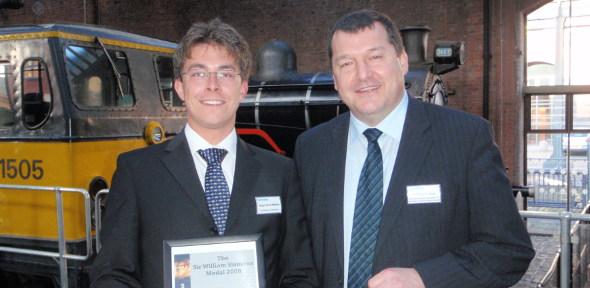
Hugo Scott Whittle, a 4th year undergraduate in the Information Engineering division of the Department, was awarded a Sir William Siemens Medal at a prize-giving ceremony held in the Museum of Science and Industry, Manchester, earlier this year. Hugo was accompanied and introduced at the event by Dr Peter Long of the Mechanics and Materials Division.
Sir William Siemens was a businessman and engineer, and the younger brother of Werner von Siemens, founder of Telegraphen-Bauanstalt von Siemens & Halske, the forerunner of Siemens AG. Sir William managed the company's London office and is best-known for the installation of the first electric street lighting at Godalming in Surrey, the laying of an impressive Indo-European telegraph cable and the successful completion of an ambitious project to install the first direct telegraph link to the US.
The Siemens medal was established by Imperial College London in 1883 and originally presented to the College's top final year electrical engineering student. It is now awarded annually by Siemens plc to one student from each of eighteen leading UK universities, but the bronze medal is still struck specially by the Royal Mint using one of the original dies. The medal is accompanied by a generous financial reward. At this year's ceremony, the medals were presented by Andreas Goss, Chief Executive of Siemens plc. Each university was asked to nominate one recipient using its own selection criteria; Hugo was awarded the medal based on his outstanding performance in his two third-year projects, Image Processing and Software, for which he received the highest marks.
Image Processing
The storage of 'raw' digital images (where each of the three colours in every picture element, or pixel, is represented as one of 256 levels) requires large amounts of space in computer memories and hard disks. However, it is possible to take advantage of redundancy in an image to reduce this requirement considerably. For example, in an image containing a large area of blue sky, it is not necessary to store every pixel individually, since they are all very similar; it is more efficient to record just the differences between adjacent pixels. Techniques of this sort form the basis of 'lossless' compression. It is also possible to take advantage of the characteristics of the human visual system to remove information from an image without changing its appearance: this is the aim of 'lossy' compression.
This project, for which students worked in pairs, investigated both compression methods. It made use of the Laplacian Pyramid, Discrete Cosine Transform and Discrete Wavelet Transform for energy compaction - these three techniques decompose an image into its constituent frequencies, or frequency bands, to some of which the eye is much more sensitive than others. Very high frequency image content, such as the texture of a finely woven fabric, can be 'quantized' coarsely, so only a very rough approximation to the image information needs to be stored. So-called entropy coding was also employed - like Morse code, this aims to encode commonly-occurring pieces of information (such as the 'no change' message in the blue sky example) using short codewords to reduce the total amount of data.
The Image Processing project took the form of a competition to compress three pictures to less than a thirteenth of their original size, and to uncompress them, with the students' compression systems judged on the quality of the resulting images. The systems developed used many of the techniques present in the popular JPEG and JPEG2000 image formats. Hugo was awarded a BP Design Project prize for this work.
Software
When designing modern large-scale digital circuits, it is usually too expensive and time-consuming to test every prototype using real hardware; instead, a software package is used to simulate the behaviour of the circuit on a computer. This project, carried out in teams of three, developed just such an application, called Logsim.
Logsim accepts a text file specifying how the user's chosen circuit should be constructed from simple components (logic gates, bistables and clock sources): the first task of the project was therefore to write a specification, using the EBNF language, to define precisely the format of the circuit description file and how it should be interpreted by the simulator. The bulk of the programming work was then split between the three team members, before the final integration and testing.
Logsim allows the user to define both combinational circuits (where the outputs depend only on the current inputs) and more complex sequential circuits (circuits with memory); it displays the electrical signals at particular points in the circuit over a chosen time period on a virtual 'logic analyzer' display. Switches can be incorporated into the user's design and opened and closed while the simulation is running to examine the effect on the signals being monitored, and the whole circuit can even be re-wired from the powerful graphical user interface. The software provides an intuitive, colour-coded display of the signals of interest, which can be zoomed and dragged around to better examine a particular section of a waveform and to aid understanding of the circuit's operation.
Logsim was developed using the C++ programming language, the wxWidgets user interface library and the OpenGL graphics engine, and versions were produced for both the Windows and Linux operating systems. Hugo received an i2 Computer-Based Project prize for his contribution to Logsim.

